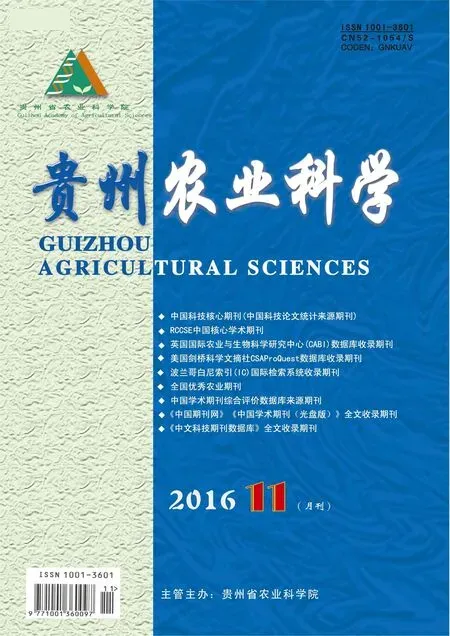天然除蟲菊素與丁醚脲復配對朱砂葉螨殺螨活性的影響
楊振國,謝道燕,達愛斯,倪 婧,羅雁婕
(云南省農業科學院蠶桑蜜蜂研究所,云南蒙自661101)
天然除蟲菊素與丁醚脲復配對朱砂葉螨殺螨活性的影響
楊振國,謝道燕,達愛斯,倪 婧,羅雁婕*
(云南省農業科學院蠶桑蜜蜂研究所,云南蒙自661101)
為減少化學農藥用量,降低農藥殘留和環境污染,有效控制朱砂葉螨的發生與危害,并為開發除蟲菊素與丁醚脲復配殺螨劑提供理論依據,采用玻片浸漬法結合共毒系數法研究天然除蟲菊素與丁醚脲混劑對朱砂葉螨的殺螨活性及最佳配比。結果表明:除蟲菊素和丁醚脲處理朱砂葉螨雌成螨24h的LC50分別為561.82mg/L和154.67mg/L;除蟲菊素與丁醚脲混劑的增效配比為1.55∶1~14.45∶1,共毒系數法評價該配比混劑的防效均呈增效作用,其中,5.42∶1混劑的增效作用最顯著,處理朱砂葉螨24h的LC50和共毒系數分別為85.20mg/L和469.31,其毒力分別是單用除蟲菊素和丁醚脲的6.59倍和1.82倍。丁醚脲和除蟲菊素混劑具有開發潛力。
朱砂葉螨;除蟲菊素;丁醚脲;共毒系數;殺螨劑;復配農藥
朱砂葉螨(Tetranychus cinnabarinus)是一種分布廣泛,危害棉花、果樹及蔬菜等100余種作物的植食性害螨,一直以來其防治主要以化學防治為主。據統計[1],2013年用于防治螨類的殺螨劑40%為乙酰輔酶A羧化酶抑制劑,24%為復合體I抑制劑,12%為ATP酶抑制劑。可見,即使殺螨劑的種類多,但其作用機制及靶標多數是相同的。研究[2-3]表明,長期使用單一作用靶標的殺螨劑,害螨易產生抗藥性或對同類藥劑的交互抗性,而多作用機制的殺螨劑可以延緩害螨抗藥性的產生并防治抗性害螨。殺螨劑復配或輪換使用是農業害螨抗藥性治理的重要措施,選擇不同作用機制的殺螨劑輪換使用可有效延緩抗藥性的產生,但是單劑輪換使用不能有效殺死已產生抗藥性的個體[4]。從理論上講,利用不同作用機制的2種殺螨劑混合,當害螨對一種藥劑產生抗性不能被殺死時,另一種藥劑能夠對其有效殺滅,相對于輪換使用,混用更具有優勢[5-7]。甲氰菊酯與阿維菌素混用對朱砂葉螨具有顯著的增效作用,且能有效延緩朱砂葉螨抗性進化,但二者輪用反而加速害螨對甲氰菊酯的抗性發展;噠螨靈與阿維菌素混用、輪用都能有效地延緩朱砂葉螨對二者的抗性進化[8-9]。因此,不同作用機制的復配殺螨劑不僅具有增效作用,還是有效防治害螨及解決害螨抗藥性的重要途徑。
天然除蟲菊素是一種植物性殺蟲劑,主要提取于除蟲菊(Chrysanthemum cinerariaefolium)和紅花除蟲菊(C.cineum)的花[10-11]。天然除蟲菊素包括除蟲菊素I(pyrethrins I)、除蟲菊素II(pyrethrins II)、瓜葉菊素I(cinerin I)、瓜葉菊素II(cinerin II)、茉酮菊素I(jasmolin I)和茉酮菊素II(jasmolin I)等6個殺蟲活性成分[11-12]。除蟲菊素是典型的神經毒劑,直接作用于可興奮膜,干擾膜的離子傳導,主要影響神經膜的鈉通道,使興奮時鈉傳導增加的消失過程延緩,致使跨膜鈉離子流延長,引起感覺神經纖維和運動神經軸反復活動,短暫的神經細胞去極化和持續的肌肉收縮。高濃度時則抑制神經膜的離子傳導,阻斷興奮[13]。除蟲菊素對多種昆蟲均有毒殺作用[14-15],對朱砂葉螨[16]、腐食酪螨(Tyrophagus putrescentiae)[17]及人疥螨(Sarcoptes scabiei)[18]等也有較好的防效。丁醚脲是一種新型硫脲類殺蟲和殺螨劑,具有觸殺、胃毒、內吸和熏蒸作用,其在紫外線照射下或在蟲體內多功能氧化酶的作用下分解為碳化二亞胺衍生物后才具有生物活性。碳化二亞胺能夠選擇性地共價結合線粒體內膜的Fo-ATP酶和外膜孔蛋白而抑制線粒體呼吸作用,阻礙害蟲體內神經細胞線粒體功能的發揮,影響其呼吸作用及能量轉換,從而使害蟲僵死[19-24]。丁醚脲對靶標生物的選擇性主要取決于機體中線粒體的保守性,故對哺乳動物低毒,但對斑馬魚、河蝦等水生生物為高毒,對蜜蜂和天敵昆蟲無選擇性[25-26]。除蟲菊素與丁醚脲在作用機制及靶標方面的差異性,是篩選不同作用機制復配殺螨劑的基礎。筆者采用玻片浸漬法結合共毒系數法研究二者不同比例混劑對朱砂葉螨的殺螨活性及毒力,旨在減少化學農藥用量,降低農藥殘留和環境污染,篩選除蟲菊素與丁醚脲最佳增效配比,為開發除蟲菊素與丁醚脲復配殺螨劑提供理論依據。
1材料與方法
1.1供試材料
1.1.1螨類 朱砂葉螨,采自云南省蒙自市桑園。
1.1.2藥劑98%丁醚脲(Diafenthiuron)由上海宜升化學技術有限公司生產,59.8%天然除蟲菊素(pyrethrins)由昆明農藥廠生產。
1.2試驗方法
1.2.1材料預處理1)朱砂葉螨。在智能人工氣候室內(26±1)℃,RH 60%~80%,光周期14L∶10D條件下用蛭石盆栽菜豆苗飼養,擴繁后作為供試螨類。2)藥劑。試驗前稱取適量原藥置于容量瓶內,用丙酮充分溶解,并定容為10 000mg/L的母液,將其放入4℃冰箱內保存備用。
1.2.2混劑增效配比的篩選與最佳配比的確定首先測定天然除蟲菊素和丁醚脲的致死中濃度(LC50),將2種藥劑的LC50藥液按體積比為10∶0、9∶1、8∶2、7∶3、6∶4、5∶5、4∶6、3∶7、2∶8、1∶9 及0∶10混合配制成不同比例的混劑,以0.1%吐溫-80水溶液作對照,測定其對朱砂葉螨處理24h后的死亡率。用SPSS軟件經Duncan新復極差法比較各處理之間的效果差異,若某一配比組合的死亡率在統計上顯著大于2個單劑在LC50時的死亡率,則表示該配比組合具有增效作用。另外,采用校正毒力比(Corrected Toxicity Ratio,CTR)判斷其增效程度,當校正毒力比顯著大于1為增效作用,顯著小于1為拮抗作用,等于1為相加作用[27]。在篩選出混劑的增效配比范圍后進一步測定各配比對朱砂葉螨的毒力,以共毒系數法評價其增效程度,確定最佳配比。共毒系數大于100為增效作用,小于80為拮抗作用,介于80~100為相加作用[28]。
毒力比(TR)=實際死亡率/預期死亡率
校正毒力比(CTR)=混劑毒力比/單劑平均毒力比
毒力指數(TI)=(標準藥劑LC50/供試藥劑LC50)×100
混劑實測毒力指數(ATI)=(標準藥劑LC50/混劑LC50)×100
混劑理論毒力指數(TTI)=TIA×PA+TIB× PB
混劑共毒系數(CTC)=(混劑ATI/混劑TTI)×100
式中,A和B代表2種單劑,PA和PB為單劑在混劑中的百分含量。
1.2.3殺螨活性測定 參照聯合國糧農組織(FAO)推薦的玻片浸漬法[29]測定藥劑的殺螨活性。將朱砂葉螨雌成螨挑在貼有雙面膠的玻片上,在溫度(26±1)℃、RH 60%~80%環境下放置4h,用雙目解剖鏡檢查,剔除死亡和不活潑的個體,記錄活螨數。將玻片粘有螨蟲的一端浸入供試液中5s后取出,用濾紙將螨體周圍的藥液吸盡。每種濃度處理120頭成螨,3次重復。處理培養24h后檢查成螨死亡情況。用毛筆輕觸螨體,以其螯肢不動者為死亡。
1.3數據統計與分析
所有數據采用SPSS 17.0軟件進行統計與分析,各處理間的顯著性差異比較采用Duncan新復極差檢驗,毒力回歸分析用Finney幾率值分析法。
2結果與分析
2.1單劑對朱砂葉螨的殺螨活性
從表1可見,丁醚脲與除蟲菊素對朱砂葉螨雌成螨的殺螨活性,其LC50分別為154.67mg/L和561.82mg/L;LC90分別為345.23mg/L和1 063.34mg/L。
2.2除蟲菊素-丁醚脲混劑對朱砂葉螨的殺螨活性
從表2可知,除蟲菊素-丁醚脲混劑各處理朱砂葉螨雌成螨的實際死亡率均大于預期死亡率。其中,處理4和處理9朱砂葉螨雌成螨的實際死亡率顯著大于預期死亡率(P<0.05),處理5~8的實際死亡率分別為79.86%、86.43%、90.95%和82.45%,極顯著大于預期死亡率(P<0.01)。經校正毒力比評價,處理4~9除蟲菊素-丁醚脲混劑的校正毒力比大于1,表現為增效作用,而處理6和處理7的校正毒力比較其他處理大,分別為3.55∶1 和3.60∶1,增效最明顯。因此,處理4~9除蟲菊素-丁醚脲混劑對朱砂葉螨的防效表現為增效作用,即除蟲菊素-丁醚脲混劑對朱砂葉螨的增效配比為1.55∶1~14.45∶1。

表1 丁醚脲與除蟲菊素對朱砂葉螨處理后24h的毒力Table 1 Toxicities of diafenthiuron and pyrethrins against T.cinnabarinus at 24hours post-treatment

表2 除蟲菊素-丁醚脲不同配比混劑對朱砂葉螨處理24h后的殺螨活性及其校正毒力比Table 2 The toxicity ratio and acaricidal activities of mixtures contained different proportion of diafenthiuron and pyrethrins against T.cinnabarinus at 24hours post-treatment
2.3除蟲菊素-丁醚脲混劑的最佳配比確定
除蟲菊素-丁醚脲混劑對朱砂葉螨的增效配比為1.55∶1~14.45∶1,以除蟲菊素為標準藥劑,進一步測得該增效范圍內各配比(1.55∶1、2.41∶1、3.61∶1、5.42∶1、8.43∶1和14.45∶1)混劑對朱砂葉螨的室內毒力(表3),即,處理24h后,配比1.55∶1、2.41∶1、3.61∶1、5.42∶1、8.43∶1和14.45∶1的除蟲菊素-丁醚脲混劑對朱砂葉螨的LC50分別為136.23mg/L、131.82mg/L、98.08mg/L、85.20mg/L、103.03mg/L和123.40mg/L;除蟲菊素-丁醚脲的共毒系數分別為200.89、243.25、361.41、469.31、427.00和389.19;其毒力分別比除蟲菊素和丁醚脲的毒力增加4.12倍和1.14倍、4.26倍和1.1 7倍、5.7 3倍和1.5 8倍、6.5 9倍和1.8 2倍、5.45倍和1.50倍、4.55倍和1.25倍。因此,除蟲菊素-丁醚脲混劑對朱砂葉螨具協同作用,其配比在1.55∶1~14.45∶1均表現為顯著的增效作用,其中,配比5.42∶1增效最明顯,是除蟲菊素-丁醚脲混劑的最佳配比。

表3 除蟲菊素-丁醚脲不同配比混劑對朱砂葉螨處理后24h的毒力Table 3 Toxicities of mixtures with different proportion of diafenthiuron-pyrethrins against T.cinnabarinus at 24hours post-treatment
3結論與討論
農藥的復配研究一直以來都是農藥研發的重要途徑之一,復配劑具有提高藥劑的防治效果、減少用量、有效防止或延緩害蟲的抗藥性的發展、降低防治成本、減少農藥殘留等多種優勢[30]。程英等[31]研究表明,小菜蛾對阿維菌素與高效氯氰菊酯復配劑的抗性發展低于單獨使用高效氯氰菊酯的抗性發展。21%螺螨酯·阿維菌素水乳劑與24%螺螨酯乳油在同等系數倍數的殺螨防效不存在顯著性差異,可有效降低螺螨酯的用量[32]。本研究結果表明,除蟲菊素與丁醚脲以1.55∶1~14.45∶1混合使用對朱砂葉螨的殺螨活性均呈增效作用,其中,5.42∶1的混劑對朱砂葉螨的毒力比原藥除蟲菊素和丁醚脲對朱砂葉螨的毒力分別增加6.59倍和1.82倍,共毒系數可達469.31,顯著大于100,具顯著的殺螨作用,同樣顯著減低單劑的使用量,且顯著提高殺螨活性,是值得開發應用的復配殺螨劑配方。本研究的增效配方僅針對朱砂葉螨,且仍在原藥配方篩選階段,復配劑也有可能增加毒性。因此,加工為制劑后的增效作用、環境安全性及毒性等還有待進一步研究。
[1]VAN LEEUWEN T,TIRRY L,YAMAMOTO A,et al.The economic importance of acaricides in the control of phytophagous mites and an update on recent acaricide mode of action research[J].Pestic Biochem Physiol,2015,121:12-21.
[2]VAN LEEUWEN T,DERMAUW W,GRBIC M,et al.Spider mite control and resistance management:does a genome help?[J].Pest Management Science,2013,69(2):156-159.
[3]VAN LEEUWEN T,VONTAS J,TSAGKARAKOU A,et al.Acaricide resistance mechanisms in the two-spotted spider mite Tetranychus urticae and other important Acari:A review[J].Insect Biochemistry and Molecular Biology,2010,40(8):563-572.
[4]SHI X Q,XIONG M H,JIANG W H,et al.Efficacy of endosulfan and fipronil and joint toxic action of endosulfan mixtures against Leptinotarsa decemlineata(Say)[J].Journal of Pest Science,2012,85(4):519-526.
[5]AHMAD M,SALEEM M A,SAYYED A H.Efficacy of insecticide mixtures against pyrethroid-and organophosphate-resistant populations of Spodoptera litura(Lepidoptera:Noctuidae)[J].Pest Management Science,2009,65(3):266-274.
[6]MARTIN T,OCHOu O G,VAISSAYRE M,et al.Organophosphorus insecticides synergize pyrethroids in the resistant strain of cotton bollworm,Helicoverpa armigera(H bner)(Lepidoptera:Noctuidae)from West Africa[J].Journal of Economic Entomology,2003,96(2):468-474.
[7]ATTIQUE M N R,KHALIQ A,SAYYED A H.Could resistance to insecticides in Plutella xylostella (Lep.,Plutellidae)be overcome by insecticide mixtures?[J].Journal of Applied Entomology,2006,130(2):122-127.
[8]何 林,趙志模,鄧新平,等.朱砂葉螨對3種殺螨劑的抗性選育及抗性治理研究[J].中國農業科學,2003,36(4):403-408.
[9]張 偉,鄧新平,羅公樹,等.10%甲氰·阿維乳油配方的篩選及其對朱砂葉螨的聯合作用[J].農藥學學報,2004,6(2):80-83.
[10]COX C.Pyrethrins/pyrethrum[J].Journal of Pesticide Reform,2002,22(1):14-20.
[11]DAVIES T,FIELD L,USHERWOOD P,et al.DDT,pyrethrins,pyrethroids and insect sodium channels[J].IUBMB life,2007,59(3):151-162.
[12]LI J,YIN L Y,JONGSMA M A,et al.Effects of light,hydropriming and abiotic stress on seed germination,and shoot and root growth of pyrethrum (Tanacetum cinerariifolium)[J].Industrial Crops and Products,2011,34:1543-1549.
[13]SCHLEIER J J,PETERSON R K,MACEDO P A,et al.Environmental concentrations,fate,and risk assessment of pyrethrins and piperonyl butoxide after aerial ultralow-volume applications for adult mosquito management[J].Environmental Toxicology and Chemistry,2008,27(5):1063-1068.
[14]CAI H J,YOU M S,FU J W,et al.Lethal effects of pyrethrins on spruce budworm(Choristoneura fumiferana)[J].Journal of Forestry Research,2010,21(3):350-354.
[15]CHEN Y C.Reseach and application of botanical pesticides in control of tobacco pest[J].Plant Diseases and Pests,2010,1(1):46-49.
[16]LI S P,ZHAO M F,CHEN W R,et al.Efficacy of 5%pyrethrin on Tetranychus cinnabarinus of Calathea makoyana[J].Northern Horticulture,2012,36(4):134-135.
[17]NAYAK M K.Management of mould mite Tyrophagus putrescentiae(Schrank)(Acarina:Acaridae):a case study in stored animal feed[J].International Pest Control,2006,48(3):128-130.
[18]PASAY C,ARLIAN L,MORGAN M,et al.The effect of insecticide synergists on the response of scabies mites to pyrethroid acaricides[J].PLoS Neglec-ted Tropical Diseases,2009,3(1):e354.
[19]KAYSER H,EILINGER P.Metabolism of diafenthiuron by microsomal oxidation:procide activation and inactivation as mechanisms contributing to selectivity[J].Pest Management Science,2001,57(10):975-980.
[20]PETROSKE E,CASIDA J E.Diafenthiuron action:carbodiimide formation and ATPase inhibition[J].Pesticide Biochemistry and Physiology,1995,53(1):60-74.
[21]RUDER F,KAYSER H.The thiourea insecticide diafenthiuron inhibits mitochondrial ATPase in vitro and in vivo by its carbodiimide product[J].Biochemical Society Transactions,1994,22(1):241-244.
[22]RUDER F J,GUYER W,BENSON J A,et al.The thiourea insecticide/acaricide diafenthiuron has a novel mode of action:inhibition of mitochondrial respiration by its carbodiimide product[J].Pesticide Biochemistry and Physiology,1991,41(2):207-219.
[23]RUDER F J,KAYSER H.The carbodiimide product of diafenthiuron reacts covalently with two mitochondrial proteins,the Fo-proteolipid and porin,and inhibits mitochondrial ATPase in vitro[J].Pesticide Biochemistry and Physiology,1992,42(3):248-261.
[24]RUDER F J,KAYSER H.The carbodiimide product of diafenthiuron inhibits mitochondria in vivo[J].Pesticide Biochemistry and Physiology,1993,46(2):96-106.
[25]GHANIM M,KONTSEDALOV S.Susceptibility to insecticides in the Q biotype of Bemisia tabaci is correlated with bacterial symbiont densities[J].Pest Management Science,2009,65(9):939-942.
[26]RAJABASKAR D,REGUPATHY A.Acute and selective toxicity of diafenthiuron and profenofos against Sciothrips cardamomi Ramk.and Conogethes punctiferalis Guenee of small cardamom[J].Resistant Pest Management Newsletter,2008,18(1):32-40.
[27]王小藝,王躍龍,歐曉明.農藥混劑配比研究的一種實用尋優方法初探[J].農藥學學報,2005,7(1):40-44.
[28]SUN Y P,JOHNSON E R.Analysis of joint action of insecticides against house flies[J].Journal of Economic Entomology,1960,53(5):887-892.
[29]BUSVINE J R.Recommended methods for measurement of resistance to pesticides[J].Plant Production and Protection Paper,1980,21:49-54.
[30]程 英,金劍雪,李忠英,等.殺蟲劑復配對斜紋夜蛾幼蟲的生物活性分析[J].貴州農業科學,2009,37 (9):92-94.
[31]程 英,李鳳良,金劍雪,等.小菜蛾對阿維菌素和高效氯氰菊酯及其復配劑的抗性[J].貴州農業科學,2015,43(2):47-49.
[32]陳才俊,李汶錕,廖國會,等.21%螺螨酯·阿維菌素水乳劑的研制[J].貴州農業科學,2014,42(5):106-108.
(責任編輯:王 海)
Effect of Activity of Natural Pyrethrins and Diafenthiuron Mixture Against Tetranychus cinnabarinus
YANG Zhenguo,XIE Daoyan,DA Aisi,NI Jing,LUO Yanjie*
(Institute of Sericulture &Apiculture,Yunnan Academy of Agricultural Sciences,Mengzi,Yunnan 661101,China)
In order to reduce the application of chemical pesticides,pesticide residues and environmental pollution,so as to effectively control the occurrence and harm of T.cinnabarinus,and provide theoretical basis for the exploitation of pyrethrins and diafenthiuron mixed acaricide,Slide-dip method and co-toxicity coefficient method were employed to explore the acaricidal activity and the optimum ratio.Results:The median lethal concentration(LC50)of pyrethrins and diafenthiuron against T.cinnabarinus female adults were 561.82mg/L and 154.67mg/L,respectively.The synergistic mass ratios of pyrethrins and diafenthiuron ranged from 1.55∶1to 14.45∶1,and the effects of mixtures were synergistic via CTC method,and the optimal diafenthiuron-to-pyrethrins ratio was 5.42∶1.At 24hposttreatment,the LC50value and co-toxicity coefficient(CTC)of the optimal diafenthiuron-to-pyrethrins ratio against T.cinnabarinus female mites were 85.20mg/L and 469.31,and toxicity relatived to diafenthiuron and pyrethrins were 1.82and 6.59times,respectively.All these results indicated that the synergistic activity of natural pyrethrins and diafenthiuron opens an opportunity for developing a new mixture acaricide.
Tetranychus cinnabarinus;pyrethrins;diafenthiuron;co-toxicity coefficient;acaricide;combination of pesticides
S482.5
A
1001-3601(2016)11-0463-0056-05
2016-03-03;2016-10-18修回
云南省科技計劃重點新產品項目“云南重大農業害螨綜合防控關鍵技術研究應用及殺螨劑開發”(2015BB009);云南省農業科學院蠶桑蜜蜂研究所青年創新基金項目“基于家蠶安全性的丁醚脲復配殺螨劑研制”(QC2014003)
楊振國(1986-),男,研究實習員,從事殺螨劑研究與開發。E-mail:zhenguoyang@qq.com
*通訊作者:羅雁婕(1979-),女,副研究員,從事農業昆蟲與害蟲防治研究。E-mail:yanjieluo@126.com

